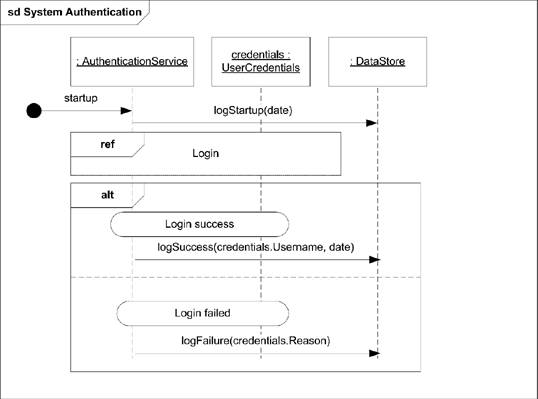Section 10.11. Continuations
10.11. ContinuationsTypically used with interaction references, continuations allow you to define different branches of an alternative interaction outside of the alternative itself. Continuations are conceptually similar to named blocks of functionality. The notation for continuations can be particularly confusing. You show a continuation using the symbol for states, a rectangle with rounded sides; however, the position of the rectangle changes the meaning of the diagram. You place a continuation at the beginning of an interaction to define the behavior for that continuation. You use a continuation by showing the rectangle at the end of an interaction. Finally, continuations with the same name must cover the same lifelines (and only those lifelines). Figure 10-34 shows the first of three sequence diagrams demonstrating a continuation; this one displays the details of a Login sequence. After the password is retrieved from the database, an alternative interaction is entered. If the passwords match, various flags are set on the UserCredentials. After setting the flags, there is a continuation named Login success, in which users of this sequence diagram can plug in their own functionality. If the passwords don't match, the else part of the alternative interaction executes, which leads to the Login failed continuation. Notice the continuation symbols are at the end of each interaction operand, indicating this diagram uses an externally defined continuation. Figure 10-34. Using a continuation in a sequence diagram Figure 10-35 shows the second diagram, a sequence diagram that makes use of the Login sequence and defines continuations for Login success and Login failed. If the correct password was entered, the Login success continuation is executed; otherwise, the Login failed continuation is run. Notice in this diagram that the continuation symbols are at the top of the interaction, indicating that this diagram defines the behavior to execute. Figure 10-35. Defining continuations in a sequence diagram Taken together, these two diagrams are equivalent to Figure 10-36. |
EAN: 2147483647
Pages: 132